3D Digital Impression Systems Compared with Traditional Techniques in Dentistry: A Recent Data Systematic Review
Abstract
1. Introduction
1.1. Background
1.2. Aim
2. Materials and Methods
2.1. Protocol and Registration
2.2. Eligibility Criteria
- Digital impression technique study
- Conventional impression technique study
- On human Study
- Randomized Controlled Trial (RCT) or Clinical Trial (CT)
- Last 10 years study.
- Studies involving patients with systemic disease and other pathologies
- Studies about experimental instruments
- Both accessible studies and not on English Language
2.3. Information Sources
2.4. Search
2.5. Study Selection
2.6. Data Collection Process
2.7. Data Items
2.8. Risk of Bias in Individual Studies
2.9. Summary Measures
2.10. Synthesis of Results
2.11. Risk of Bias Across Studies
2.12. Additional Analyses
3. Results
3.1. Study Selection
3.2. Study Characteristics
3.3. Results of Individual Studies
3.4. Synthesis of Results
3.5. Additional Analysis
4. Discussion
4.1. Summary of Evidence
4.2. Limitations
5. Conclusions
Author Contributions
Funding
Acknowledgments
Conflicts of Interest
References
- Cervino, G.; Fiorillo, L.; Herford, A.S.; Laino, L.; Troiano, G.; Amoroso, G.; Crimi, S.; Matarese, M.; D’Amico, C.; Nastro Siniscalchi, E.; et al. Alginate materials and dental impression technique: A current state of the art and application to dental practice. Mar. Drugs 2018, 17, 18. [Google Scholar] [CrossRef] [PubMed]
- Patel, J.; Winters, J.; Walters, M. Intraoral digital impression technique for a neonate with bilateral cleft lip and palate. Cleft Palate-Craniofacial J. 2019, 56, 1120–1123. [Google Scholar] [CrossRef] [PubMed]
- Pagano, S.; Moretti, M.; Marsili, R.; Ricci, A.; Barraco, G.; Cianetti, S. Evaluation of the accuracy of four digital methods by linear and volumetric analysis of dental impressions. Materials 2019, 12, 1958. [Google Scholar] [CrossRef] [PubMed]
- Cervino, G.; Fiorillo, L.; Arzukanyan, A.V.; Spagnuolo, G.; Cicciu, M. Dental restorative digital workflow: Digital smile design from aesthetic to function. Dent. J. 2019, 7, 30. [Google Scholar] [CrossRef]
- Lavorgna, L.; Cervino, G.; Fiorillo, L.; Di Leo, G.; Troiano, G.; Ortensi, M.; Galantucci, L.; Cicciù, M. Reliability of a virtual prosthodontic project realized through a 2d and 3d photographic acquisition: An experimental study on the accuracy of different digital systems. Int. J. Environ. Res. Public Health 2019, 16, 5139. [Google Scholar] [CrossRef]
- Molinero-Mourelle, P.; Lam, W.; Cascos-Sanchez, R.; Azevedo, L.; Gomez-Polo, M. Photogrammetric and intraoral digital impression technique for the rehabilitation of multiple unfavorably positioned dental implants—A clinical report. J. Oral Implant. 2019, 45, 398–402. [Google Scholar] [CrossRef]
- Mendes, T.A.; Marques, D.; Lopes, L.P.; Carames, J. Total digital workflow in the fabrication of a partial removable dental prostheses: A case report. Sage Open Med. Case Rep. 2019, 7, 2050313x19871131. [Google Scholar] [CrossRef]
- Kihara, H.; Hatakeyama, W.; Komine, F.; Takafuji, K.; Takahashi, T.; Yokota, J.; Oriso, K.; Kondo, H. Accuracy and practicality of intraoral scanner in dentistry: A literature review. J. Prosthodont. Res. 2019. [Google Scholar] [CrossRef]
- Tian, J.H.; Ge, L.; Li, L. The PRISMA Extension Statement. Ann. Intern. Med. 2015, 163, 566. [Google Scholar] [CrossRef]
- Liu, H.; Zhou, X.; Yu, G.; Sun, X. The effects of the PRISMA statement to improve the conduct and reporting of systematic reviews and meta-analyses of nursing interventions for patients with heart failure. Int. J. Nurs. Pr. 2019, 225, e12729. [Google Scholar] [CrossRef]
- Hutton, B.; Salanti, G.; Caldwell, D.M.; Chaimani, A.; Schmid, C.H.; Cameron, C.; Ioannidis, J.P.; Straus, S.; Thorlund, K.; Jansen, J.P.; et al. The PRISMA extension statement for reporting of systematic reviews incorporating network meta-analyses of health care interventions: Checklist and explanations. Ann. Intern. Med. 2015, 162, 777–784. [Google Scholar] [CrossRef] [PubMed]
- Da Costa Santos, C.M.; de Mattos Pimenta, C.A.; Nobre, M.R. The PICO strategy for the research question construction and evidence search. Rev. Lat. Am. De Enferm. 2007, 15, 508–511. [Google Scholar] [CrossRef] [PubMed]
- Higgins, J.P.; Altman, D.G.; Gøtzsche, P.C.; Jüni, P.; Moher, D.; Oxman, A.D.; Savović, J.; Schulz, K.F.; Weeks, L.; Sterne, J.A. The Cochrane Collaboration’s tool for assessing risk of bias in randomised trials. BMJ (Clin. Res. Ed) 2011, 343, d5928. [Google Scholar] [CrossRef] [PubMed]
- Whiting, P.; Savović, J.; Higgins, J.P.; Caldwell, D.M.; Reeves, B.C.; Shea, B.; Davies, P.; Kleijnen, J.; Churchill, R. ROBIS: A new tool to assess risk of bias in systematic reviews was developed. Recenti Prog. Med. 2018, 109, 421–431. [Google Scholar] [CrossRef] [PubMed]
- Coburn, K.M.; Vevea, J.L. Publication bias as a function of study characteristics. Psychol. Methods 2015, 20, 310–330. [Google Scholar] [CrossRef]
- Bachelet, V.C.; Pardo-Hernandez, H. Quality of reporting and risk of bias of randomized clinical trials published in Spanish and Latin American journals. Medwave 2019, 19, e7573. [Google Scholar] [CrossRef]
- Cave, V.; Keys, W. Digital and conventional impressions have similar working times. Evid. Based Dent. 2018, 19, 84–85. [Google Scholar] [CrossRef]
- Chandran, S.K.; Jaini, J.; Babu, A.S.; Mathew, A.; Keepanasseril, A. Digital versus conventional impressions in dentistry: A systematic review. J. Clin. Diagn. Res. 2019, 13, 1–6. [Google Scholar] [CrossRef]
- Zitzmann, N.U.; Kovaltschuk, I.; Lenherr, P.; Dedem, P.; Joda, T. Dental students’ perceptions of digital and conventional impression techniques: A randomized controlled trial. J. Dent. Educ. 2017, 81, 1227–1232. [Google Scholar] [CrossRef]
- Zeltner, M.; Sailer, I.; Muhlemann, S.; Ozcan, M.; Hammerle, C.H.; Benic, G.I. Randomized controlled within-subject evaluation of digital and conventional workflows for the fabrication of lithium disilicate single crowns. Part III: Marginal and internal fit. J. Prosthet. Dent. 2017, 117, 354–362. [Google Scholar] [CrossRef]
- Sailer, I.; Muhlemann, S.; Fehmer, V.; Hammerle, C.H.F.; Benic, G.I. Randomized controlled clinical trial of digital and conventional workflows for the fabrication of zirconia-ceramic fixed partial dentures. Part I: Time efficiency of complete-arch digital scans versus conventional impressions. J. Prosthet. Dent. 2019, 121, 69–75. [Google Scholar] [CrossRef] [PubMed]
- Cappare, P.; Sannino, G.; Minoli, M.; Montemezzi, P.; Ferrini, F. Conventional versus digital impressions for full arch screw-retained maxillary rehabilitations: A randomized clinical trial. Int. J. Environ. Res. Public Health 2019, 16, 829. [Google Scholar] [CrossRef] [PubMed]
- Sakornwimon, N.; Leevailoj, C. Clinical marginal fit of zirconia crowns and patients’ preferences for impresion techniques using intraoral digital scanner versus polyvinyl siloxane material. J. Prosthet. Dent. 2017, 118, 386–391. [Google Scholar] [CrossRef] [PubMed]
- Joda, T.; Lenherr, P.; Dedem, P.; Kovaltschuk, I.; Bragger, U.; Zitzmann, N.U. Time efficiency, difficulty, and operator’s preference comparing digital and conventional implant impressions: A randomized controlled trial. Clin. Oral Implant. Res. 2017, 28, 1318–1323. [Google Scholar] [CrossRef] [PubMed]
- Joda, T.; Bragger, U. Patient-centered outcomes comparing digital and conventional implant impression procedures: A randomized crossover trial. Clin. Oral Implant. Res. 2016, 27, e185–e189. [Google Scholar] [CrossRef]
- Gherlone, E.; Cappare, P.; Vinci, R.; Ferrini, F.; Gastaldi, G.; Crespi, R. Conventional Versus Digital Impressions for “All-on-Four” Restorations. Int. J. Oral Maxillofac. Implant. 2016, 31, 324–330. [Google Scholar] [CrossRef]
- Benic, G.I.; Muhlemann, S.; Fehmer, V.; Hammerle, C.H.; Sailer, I. Randomized controlled within-subject evaluation of digital and conventional workflows for the fabrication of lithium disilicate single crowns. Part I: Digital versus conventional unilateral impressions. J. Prosthet. Dent. 2016, 116, 777–782. [Google Scholar] [CrossRef]
- Boeddinghaus, M.; Breloer, E.S.; Rehmann, P.; Wostmann, B. Accuracy of single-tooth restorations based on intraoral digital and conventional impressions in patients. Clin. Oral Investig. 2015, 19, 2027–2034. [Google Scholar] [CrossRef]
- Yilmaz, B.; Abou-Ayash, S. A digital intraoral implant scan technique using a combined healing abutment and scan body system. J. Prosthet. Dent. 2019, 123, 206–209. [Google Scholar] [CrossRef]
- Runkel, C.; Guth, J.F.; Erdelt, K.; Keul, C. Digital impressions in dentistry-accuracy of impression digitalisation by desktop scanners. Clin. Oral Investig. 2019, 24, 1249–1257. [Google Scholar] [CrossRef]
- Gjelvold, B.; Chrcanovic, B.R.; Korduner, E.K.; Collin-Bagewitz, I.; Kisch, J. Intraoral Digital Impression Technique Compared to Conventional Impression Technique. A Randomized Clinical Trial. J. Prosthodont. 2016, 25, 282–287. [Google Scholar] [CrossRef] [PubMed]
- Yuzbasioglu, E.; Kurt, H.; Turunc, R.; Bilir, H. Comparison of digital and conventional impression techniques: Evaluation of patients’ perception, treatment comfort, effectiveness and clinical outcomes. Bmc Oral Health 2014, 14, 10. [Google Scholar] [CrossRef] [PubMed]
- Nishikiori, R.; Sawajiri, M.; Okuda, T.; Otoshi, A.; Watanabe, K.; Hirata, I.; Nishijima, W.; Okazaki, M. Effect of ozonated water on the surface roughness of dental stone casts. Dent. Mater. J. 2018, 37, 740–745. [Google Scholar] [CrossRef] [PubMed]
- Azevedo, M.J.; Correia, I.; Portela, A.; Sampaio-Maia, B. A simple and effective method for addition silicone impression disinfection. J. Adv. Prosthodont. 2019, 11, 155–161. [Google Scholar] [CrossRef]
- Fiorillo, L. Chlorhexidine Gel Use in the Oral District: A Systematic Review. Gels 2019, 5, 31. [Google Scholar] [CrossRef]
- Hosseinpour, D.; Berg, J.C. The dynamic interaction of water with four dental impression materials during cure. J. Prosthodont. 2009, 18, 292–300. [Google Scholar] [CrossRef]
- Singla, Y.; Pachar, R.B.; Poriya, S.; Mishra, A.; Sharma, R.; Garg, A. Evaluation of the Efficacy of Different Mixing Techniques and Disinfection on Microbial Colonization of Polyether Impression Materials: A Comparative Study. J. Contemp. Dent. Pr. 2018, 19, 296–300. [Google Scholar]
- Cervino, G. Impression materials: Does water affect the performance of alginates? Minerva Stomatol. 2019, 8. (In press)
- Rancitelli, D.; Cicciù, M.; Lini, F.; Fumagalli, D.; Frigo, A.C.; Maiorana, C. Reproducibility of a digital method to evaluate soft tissue modifications: A study of inter and intra-operative measurement concordance. Open Dent. J. 2017, 11, 171–180. [Google Scholar] [CrossRef]
- Sasaki, J.I.; Imazato, S. Autoclave sterilization of dental handpieces: A literature review. J. Prosthodont. Res. 2019. [Google Scholar] [CrossRef]
- Rodrigues, S.B.; Franken, P.; Celeste, R.K.; Leitune, V.C.B.; Collares, F.M. CAD/CAM or conventional ceramic materials restorations longevity: A systematic review and meta-analysis. J. Prosthodont. Res. 2019. [Google Scholar] [CrossRef] [PubMed]
- Cicciù, M. Prosthesis: New Technological Opportunities and Innovative Biomedical Devices. Prosthesis 2019, 1, 1. [Google Scholar] [CrossRef]
- Ortensi, L.; Vitali, T.; Bonfiglioli, R.; Grande, F. New Tricks in the Preparation Design for Prosthetic Ceramic Laminate Veeners. Prosthesis 2019, 1, 5. [Google Scholar] [CrossRef]
- Cicciù, M.; Cervino, G.; Terranova, A.; Risitano, G.; Raffaele, M.; Cucinotta, F.; Santonocito, D.; Fiorillo, L. Prosthetic and Mechanical Parameters of the Facial Bone under the Load of Different Dental Implant Shapes: A Parametric Study. Prosthesis 2019, 1, 6. [Google Scholar] [CrossRef]
- Cervino, G.; Montanari, M.; Santonocito, D.; Nicita, F.; Baldari, R.; De Angelis, C.; Storni, G.; Fiorillo, L. Comparison of Two Low-Profile Prosthetic Retention System Interfaces: Preliminary Data of an In Vitro Study. Prosthesis 2019, 1, 7. [Google Scholar] [CrossRef]
- Mangano, F.G.; Margiani, B.; Solop, I.; Latuta, N.; Admakin, O. An Experimental Strategy for Capturing the Margins of Prepared Single Teeth with an Intraoral Scanner: A Prospective Clinical Study on 30 Patients. Int. J. Environ. Res. Public Health 2020, 17, 392. [Google Scholar] [CrossRef]
- Lo Giudice, G.; Lo Giudice, R.; Matarese, G.; Giudice, G.L.; Isola, G.; Cicciù, M.; Palaia, G.; Romeo, U. Evaluation of magnification systems in restorative dentistry. An In-Vitro study. Dent. Cadmos 2015, 83, 296–305. [Google Scholar] [CrossRef]
- Kamimura, E.; Tanaka, S.; Takaba, M.; Tachi, K.; Baba, K. In vivo evaluation of inter-operator reproducibility of digital dental and conventional impression techniques. PLoS ONE 2017, 12, e0179188. [Google Scholar] [CrossRef]
- Cho, S.-H.; Schaefer, O.; Thompson, G.A.; Guentsch, A. Comparison of accuracy and reproducibility of casts made by digital and conventional methods. J. Prosthet. Dent. 2015, 113, 310–315. [Google Scholar] [CrossRef]
- Ender, A.; Mehl, A. Accuracy of complete-arch dental impressions: A new method of measuring trueness and precision. J. Prosthet. Dent. 2013, 109, 121–128. [Google Scholar] [CrossRef]
- Ender, A.; Attin, T.; Mehl, A. In vivo precision of conventional and digital methods of obtaining complete-arch dental impressions. J. Prosthet. Dent. 2016, 115, 313–320. [Google Scholar] [CrossRef] [PubMed]
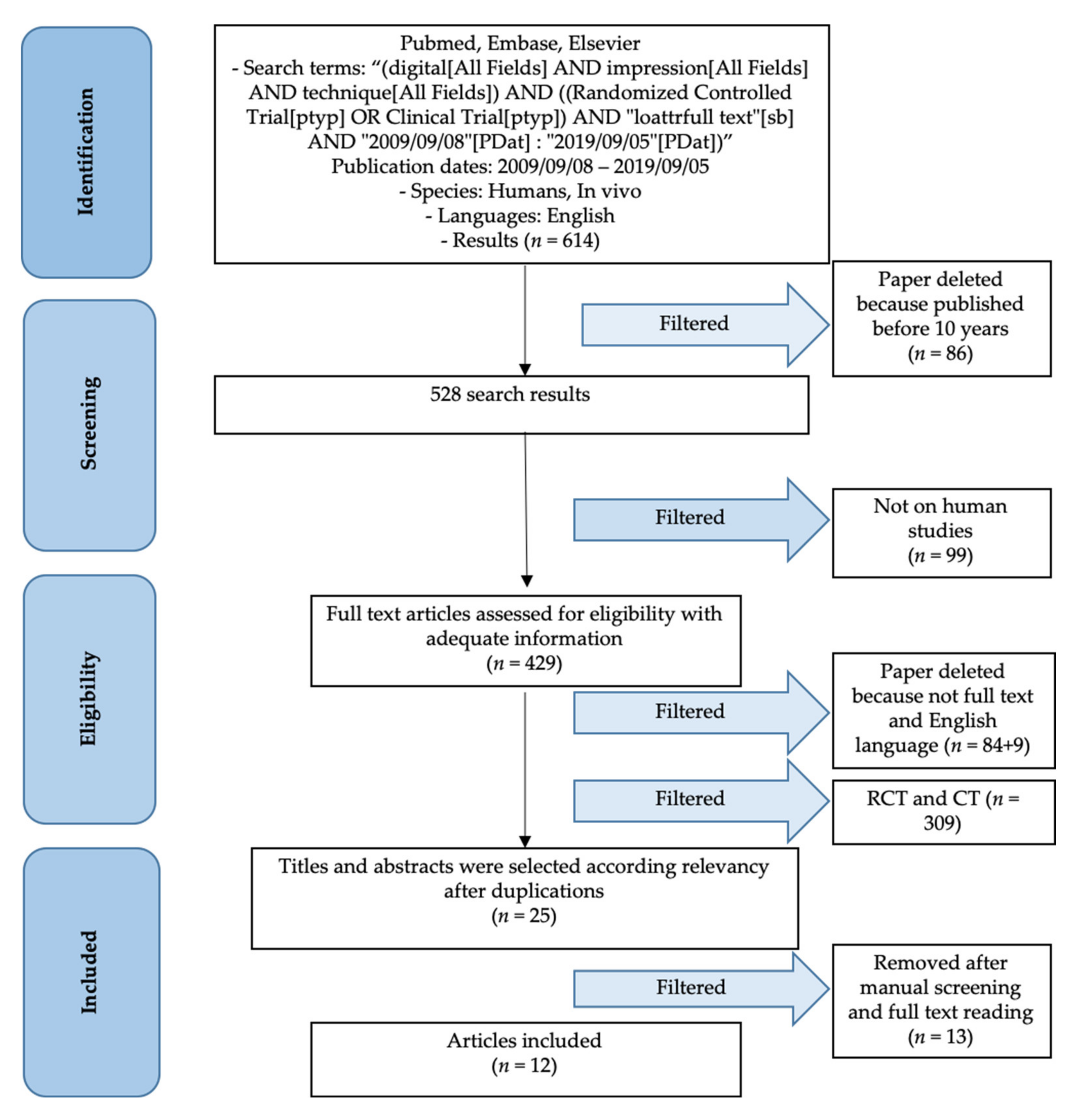
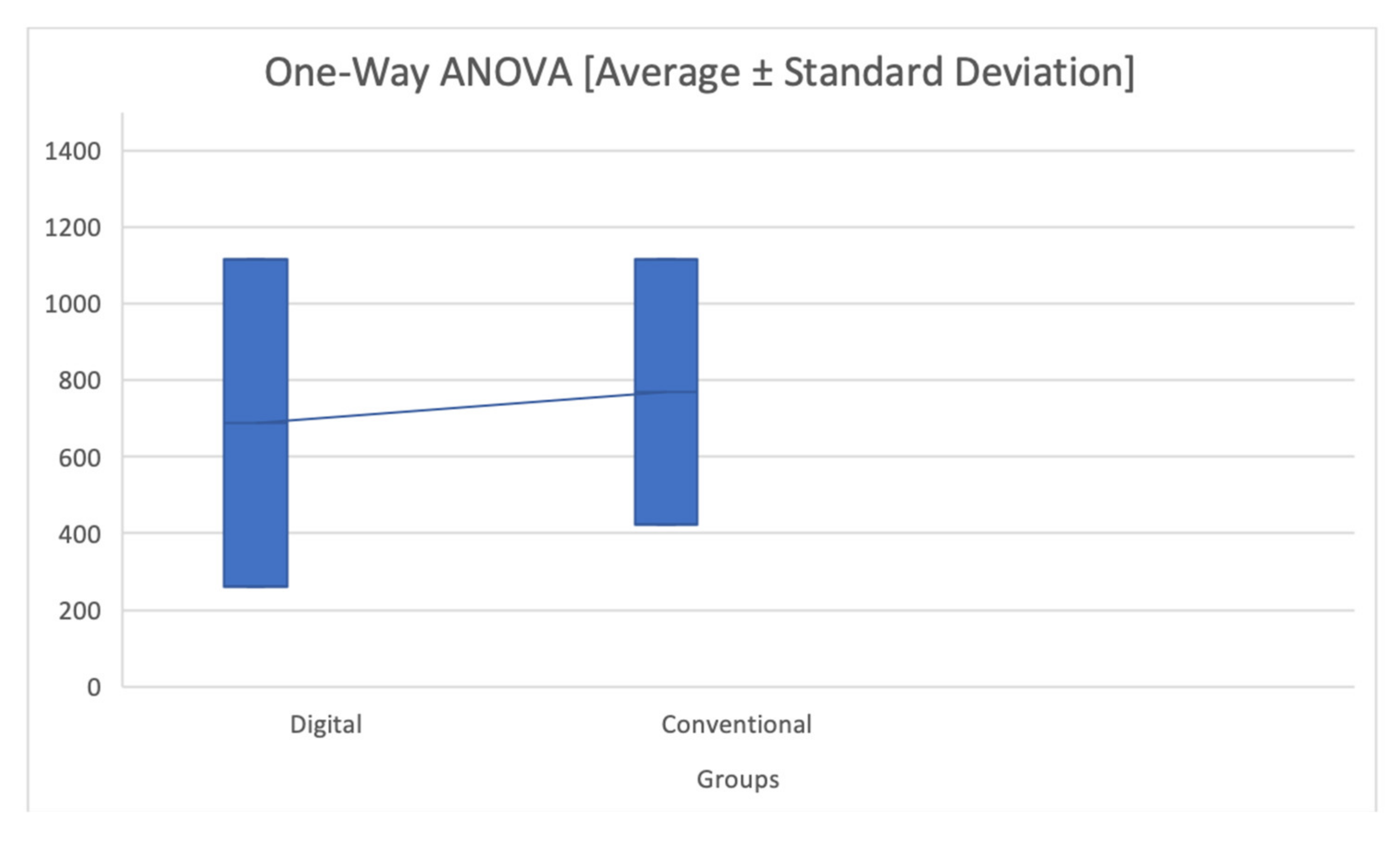
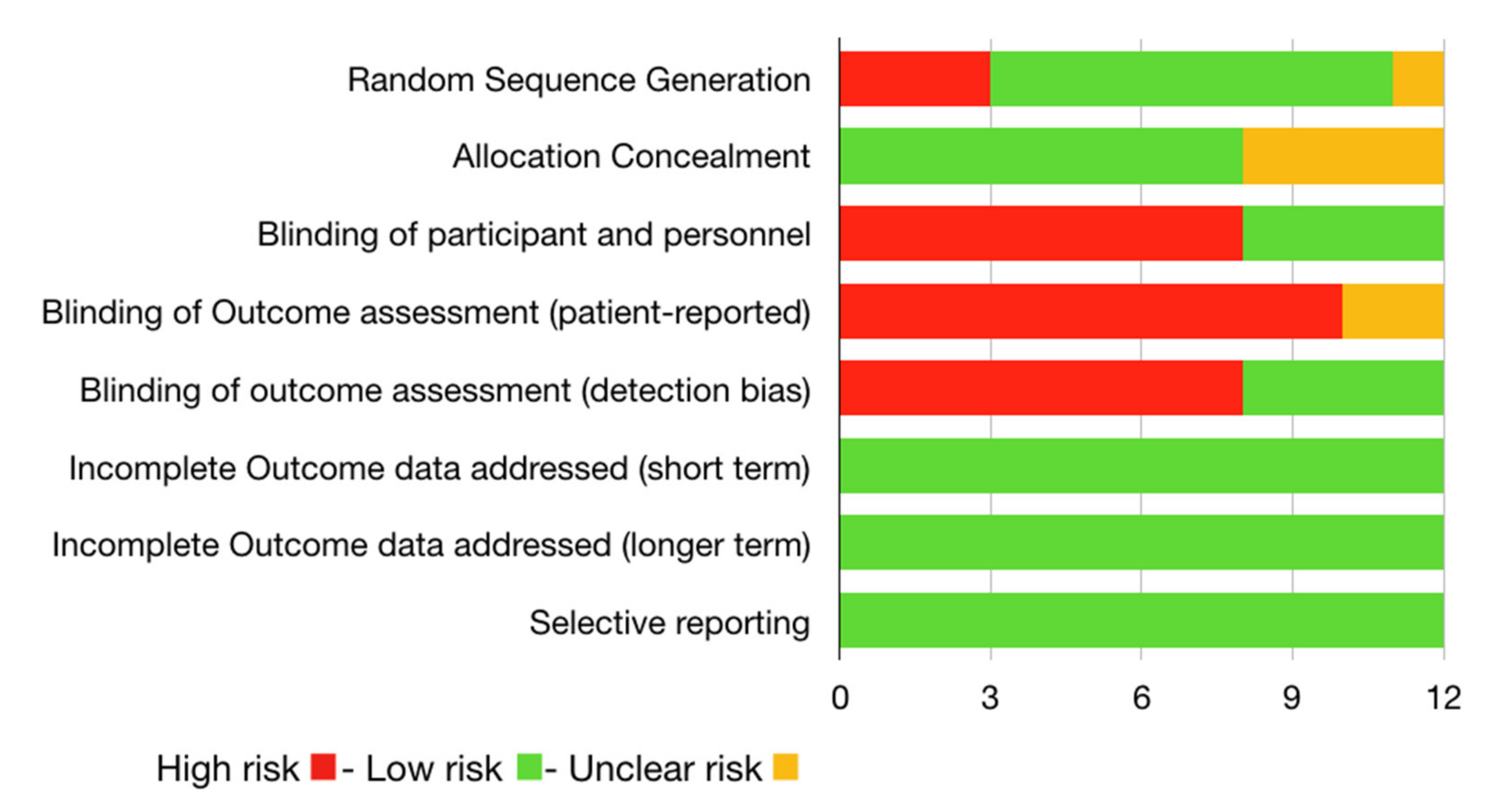
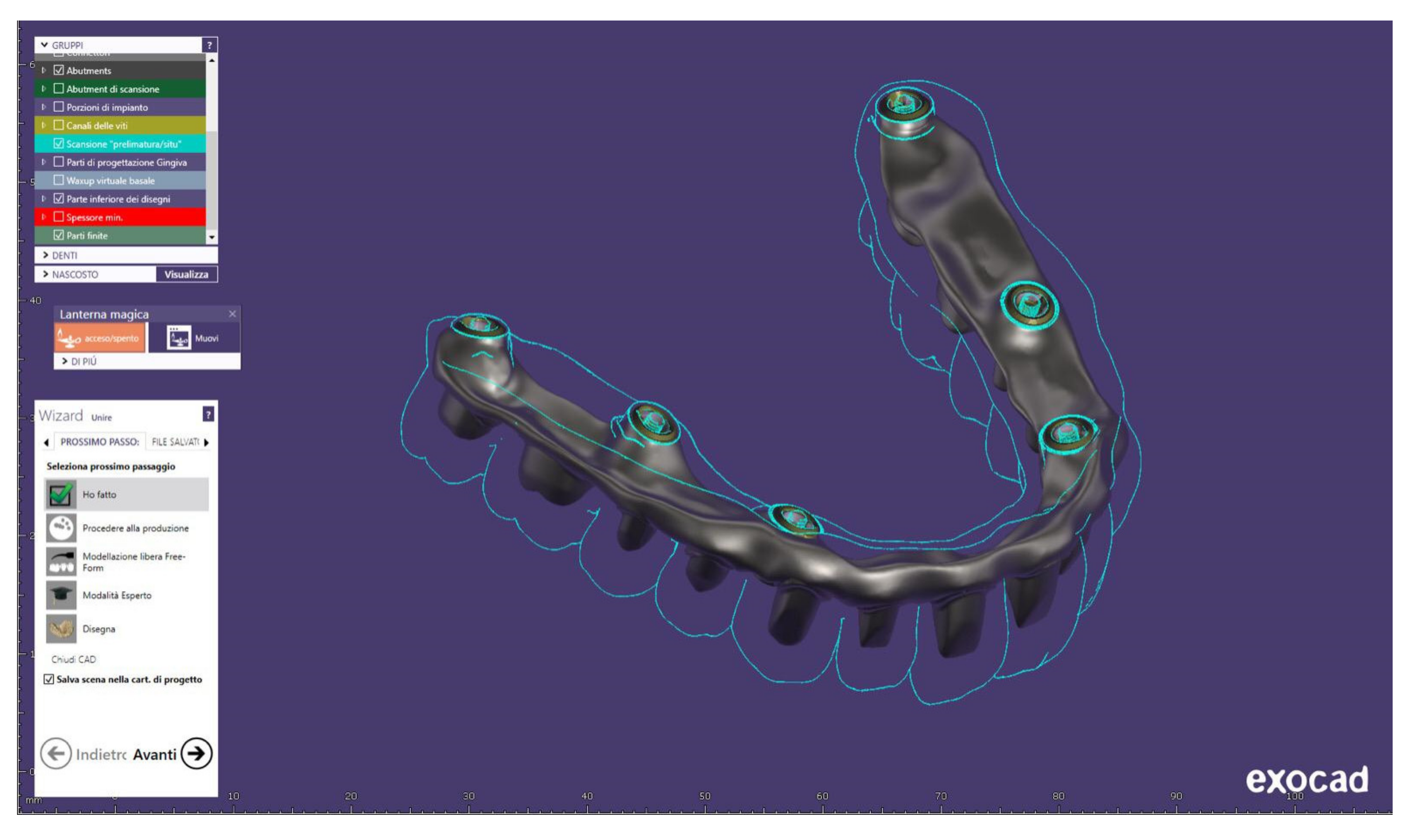
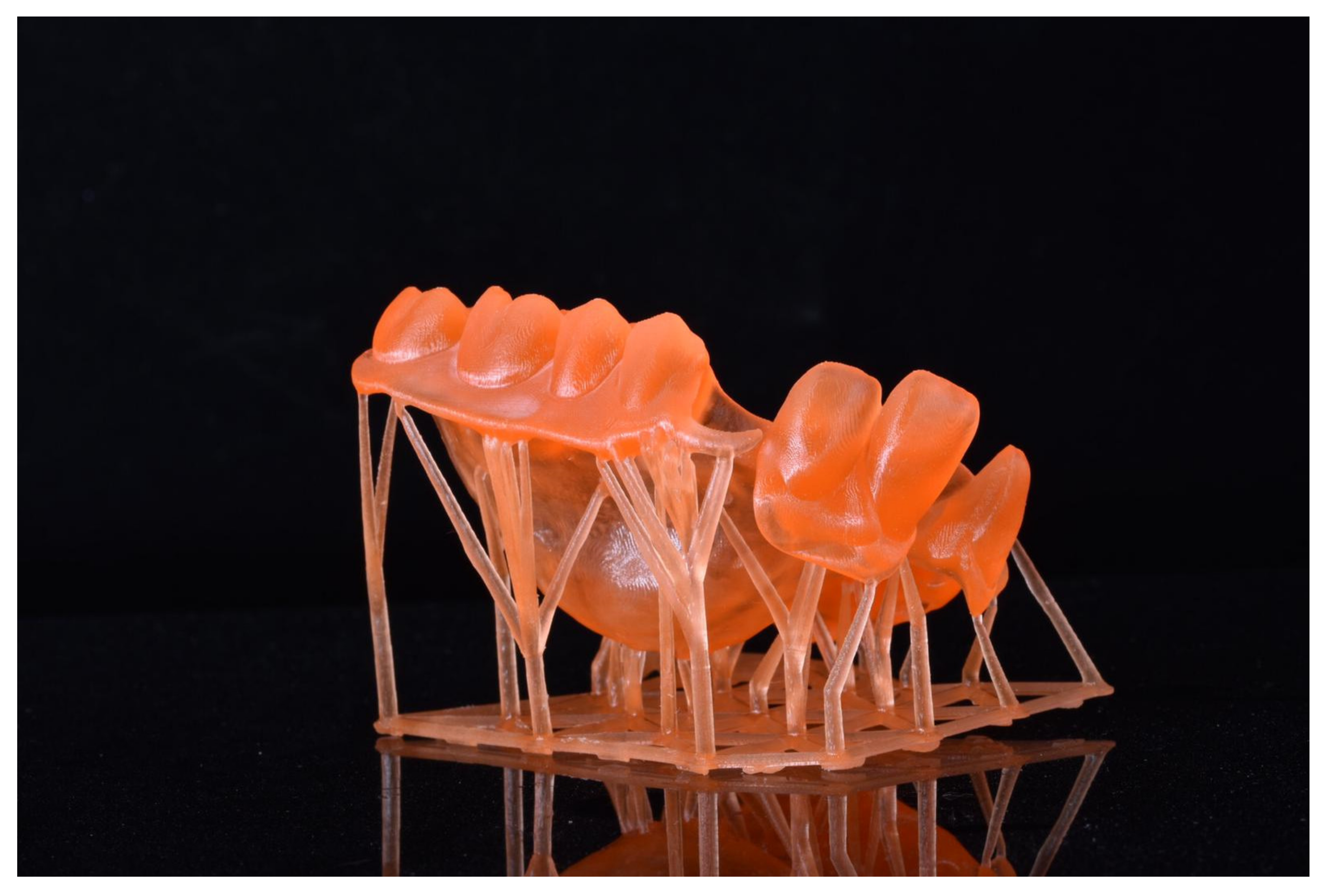
| Author and Year | Risk of Bias | |||
|---|---|---|---|---|
| Unclear | Low | Moderate | High | |
| Zitzmann et al. 2017 [19] | x | |||
| Zeltner et al. 2017 [20] | x | |||
| Sailer et al. 2019 [21] | x | |||
| Capparè et al. 2019 [22] | x | |||
| Sakornwimon et al. 2017 [23] | x | |||
| Joda et al. 2017 [24] | x | |||
| Joda et al. 2016 [25] | x | |||
| Gherlone et al. 2016 [26] | x | |||
| Benic et al. 2016 [27] | x | |||
| Boeddinghaus et al. 2015 [28] | x | |||
| Gjelvold et al. 2016 [31] | x | |||
| Yuzbasioglu et al. 2014 [32] | x | |||
| Author and Year | Entry | Risk of Bias | Support for Judgement |
|---|---|---|---|
| Zitzmann et al. 2017 [19] | Random Sequence Generation (selection bias) | High risk. | “Fifty undergraduate dental students with no clinical experience at the School of Dental Medicine, University of Basel, Switzerland were included in the study.” (Maybe no randomly) |
| Allocation Concealment (selection bias) | Low risk. | “Randomly divided” | |
| Blinding of participant and personnel (performance bias) | High risk | (cannot be conducted on digital vs. conventional impression techniques) | |
| Blinding of outcome assessment (detection bias) (patient-reported outcomes) | High risk | (cannot be conducted on digital vs. conventional impression techniques) | |
| Blinding of outcome assessment (detection bias) (Mortality) | High risk | (cannot be conducted on digital vs. conventional impression techniques) | |
| Incomplete outcome data addressed (attrition bias) (Short-term outcomes (2–6 weeks)) | Low risk | (outcomes by all participants) | |
| Incomplete outcome data addressed (attrition bias) (Longer-term outcomes (>6 weeks)) | Low risk | (outcomes by all participants) | |
| Selective reporting (reporting bias) | Low risk | Statistics has been performed on all outcomes | |
| Zeltner et al. 2017 [20] | Random Sequence Generation (selection bias) | Low risk | Random selection of participants |
| Allocation Concealment (selection bias) | Low risk | “The sequence of the crown assessment was randomly allocated according to a computer-generated list.” | |
| Blinding of participant and personnel (performance bias) | Low risk | “To eliminate operator bias, the investigators generated and evaluated the replicas without being able to distinguish among the crowns under investigation.” | |
| Blinding of outcome assessment (detection bias) (patient-reported outcomes) | High risk | Not applicable | |
| Blinding of outcome assessment (detection bias) (Mortality) | Low risk | Blinded outcome assessment | |
| Incomplete outcome data addressed (attrition bias) (Short-term outcomes (2–6 weeks)) | Low risk | Complete data | |
| Incomplete outcome data addressed (attrition bias) (Longer-term outcomes (>6 weeks)) | Low risk | Complete data | |
| Selective reporting (reporting bias) | Low risk | Complete data | |
| Sailer et al. 2019 [21] | Random Sequence Generation (selection bias) | Low risk | 10 participants in need of a tooth supported 3-unit fixed denture included |
| Allocation Concealment (selection bias) | Low risk. | “Software (www.randomizer.org) was used to create a computer-generated list of 10 sequences of the 4 tested scanning or impression procedures” | |
| Blinding of participant and personnel (performance bias) | High risk | “The same clinician carried out all the scanning and impression making on the assigned participants.” | |
| Blinding of outcome assessment (detection bias) (patient-reported outcomes) | High risk | Not specified (maybe no blinding) | |
| Blinding of outcome assessment (detection bias) (Mortality) | High risk. | Not specified (maybe no blinding) | |
| Incomplete outcome data addressed (attrition bias) (Short-term outcomes (2–6 weeks)) | Low risk | Complete data | |
| Incomplete outcome data addressed (attrition bias) (Longer-term outcomes (>6 weeks)) | Low risk | Complete data | |
| Selective reporting (reporting bias) | Low risk | No selective reporting | |
| Capparè et al. 2019 [20] | Random Sequence Generation (selection bias) | Low risk | “patients were randomly selected for this clinical study” |
| Allocation Concealment (selection bias) | Low risk | Patients have been scheduled randomly into control (conventional impression group, CIG) and test (digital impression group, DIG) groups respectively for a fully conventional workflow and a fully digital workflow. | |
| Blinding of participant and personnel (performance bias) | Low risk | “Randomization processes occurred by lots in closed envelopes and were performed by a blinded operator” | |
| Blinding of outcome assessment (detection bias) (patient-reported outcomes) | High risk | (cannot be conducted on digital vs. conventional impression techniques) | |
| Blinding of outcome assessment (detection bias) (Mortality) | High risk | (cannot be conducted on digital vs. conventional impression techniques) | |
| Incomplete outcome data addressed (attrition bias) (Short-term outcomes (2–6 weeks)) | Low risk | Follow up to 24 months | |
| Incomplete outcome data addressed (attrition bias) (Longer-term outcomes (>6 weeks)) | Low risk | Follow up to 24 months | |
| Selective reporting (reporting bias) | Low risk | No selective reporting | |
| Sakornwimon et al. 2017 [23] | Random Sequence Generation (selection bias) | High risk | Not random selection |
| Allocation Concealment (selection bias) | Unclear risk | Not specified, maybe not | |
| Blinding of participant and personnel (performance bias) | Low risk | Blinded operator | |
| Blinding of outcome assessment (detection bias) (patient-reported outcomes) | Unclear risk | No patient reported outcomes | |
| Blinding of outcome assessment (detection bias) (Mortality) | Low risk | Blinded | |
| Incomplete outcome data addressed (attrition bias) (Short-term outcomes (2–6 weeks)) | Low risk | Complete data | |
| Incomplete outcome data addressed (attrition bias) (Longer-term outcomes (>6 weeks)) | Low risk | Complete data | |
| Selective reporting (reporting bias) | Low risk | Complete data | |
| Joda et al. 2017 [24] | Random Sequence Generation (selection bias) | Low risk | Randomly selected |
| Allocation Concealment (selection bias) | Unclear risk | Not specified | |
| Blinding of participant and personnel (performance bias) | High risk | (cannot be conducted on digital vs. conventional impression techniques) | |
| Blinding of outcome assessment (detection bias) (patient-reported outcomes) | High risk | No blinding | |
| Blinding of outcome assessment (detection bias) (Mortality) | High risk | No blinding | |
| Incomplete outcome data addressed (attrition bias) (Short-term outcomes (2–6 weeks)) | Low risk | Complete data | |
| Incomplete outcome data addressed (attrition bias) (Longer-term outcomes (>6 weeks)) | Low risk | Complete data | |
| Selective reporting (reporting bias) | Low risk | Complete data | |
| Joda et al. 2016 [25] | Random Sequence Generation (selection bias) | Low risk | Random selection |
| Allocation Concealment (selection bias) | Low risk | “Random allocation” | |
| Blinding of participant and personnel (performance bias) | High risk | (cannot be conducted on digital vs. conventional impression techniques) | |
| Blinding of outcome assessment (detection bias) (patient-reported outcomes) | High risk | (cannot be conducted on digital vs. conventional impression techniques) | |
| Blinding of outcome assessment (detection bias) (Mortality) | High risk | (cannot be conducted on digital vs. conventional impression techniques) | |
| Incomplete outcome data addressed (attrition bias) (Short-term outcomes (2–6 weeks)) | Low risk | Complete data | |
| Incomplete outcome data addressed (attrition bias) (Longer-term outcomes (>6 weeks)) | Low risk | Complete data | |
| Selective reporting (reporting bias) | Low risk | Complete data | |
| Gjelvold et al. 2016 [31] | Random Sequence Generation (selection bias) | Low risk | Randomly selection |
| Allocation Concealment (selection bias) | Low risk | Randomly allocation | |
| Blinding of participant and personnel (performance bias) | High risk | (cannot be conducted on digital vs. conventional impression techniques) | |
| Blinding of outcome assessment (detection bias) (patient-reported outcomes) | Unclear risk | Not applied | |
| Blinding of outcome assessment (detection bias) (Mortality) | Low risk | “This dentist was not present at the dental office when the impressions were taken” | |
| Incomplete outcome data addressed (attrition bias) (Short-term outcomes (2–6 weeks)) | Low risk | Complete data | |
| Incomplete outcome data addressed (attrition bias) (Longer-term outcomes (>6 weeks)) | Low risk | Complete data | |
| Selective reporting (reporting bias) | Low risk | Complete data | |
| Gherlone et al. 2016 [26] | Random Sequence Generation (selection bias) | Low risk | Randomly selected |
| Allocation Concealment (selection bias) | Low risk | Randomly allocated | |
| Blinding of participant and personnel (performance bias) | High risk | (cannot be conducted on digital vs. conventional impression techniques) | |
| Blinding of outcome assessment (detection bias) (patient-reported outcomes) | High risk | Not performed | |
| Blinding of outcome assessment (detection bias) (Mortality) | High risk | Not performed | |
| Incomplete outcome data addressed (attrition bias) (Short-term outcomes (2–6 weeks)) | Low risk | Complete data | |
| Incomplete outcome data addressed (attrition bias) (Longer-term outcomes (>6 weeks)) | Low risk | Complete data | |
| Selective reporting (reporting bias) | Low risk | Complete data | |
| Benic et al. 2016 [27] | Random Sequence Generation (selection bias) | Low risk | Randomly selected |
| Allocation Concealment (selection bias) | Low risk | Randomly allocated | |
| Blinding of participant and personnel (performance bias) | Low risk | Blinded personnel | |
| Blinding of outcome assessment (detection bias) (patient-reported outcomes) | High risk | Not applicable | |
| Blinding of outcome assessment (detection bias) (Mortality) | Low risk | “The impression sequences were concealed by means of sealed envelopes until the time of the clinical procedure that required the tooth impression.” | |
| Incomplete outcome data addressed (attrition bias) (Short-term outcomes (2–6 weeks)) | Low risk | Complete data | |
| Incomplete outcome data addressed (attrition bias) (Longer-term outcomes (>6 weeks)) | Low risk | Complete data | |
| Selective reporting (reporting bias) | Low risk | Complete data | |
| Boeddinghaus et al. 2015 [28] | Random Sequence Generation (selection bias) | High risk | Not highlighted |
| Allocation Concealment (selection bias) | Unclear risk | Not specified | |
| Blinding of participant and personnel (performance bias) | High risk | (cannot be conducted on digital vs. conventional impression techniques) | |
| Blinding of outcome assessment (detection bias) (patient-reported outcomes) | High risk | High risk | |
| Blinding of outcome assessment (detection bias) (Mortality) | High risk | Random application only of digital technique | |
| Incomplete outcome data addressed (attrition bias) (Short-term outcomes (2–6 weeks)) | Low risk | Complete data | |
| Incomplete outcome data addressed (attrition bias) (Longer-term outcomes (>6 weeks)) | Low risk | Complete data | |
| Selective reporting (reporting bias) | Low risk | Complete data | |
| Yuzbasioglu et al. 2014 [32] | Random Sequence Generation (selection bias) | Unclear risk | Not specified |
| Allocation Concealment (selection bias) | Unclear risk | Not specified | |
| Blinding of participant and personnel (performance bias) | High risk | (cannot be conducted on digital vs. conventional impression techniques) | |
| Blinding of outcome assessment (detection bias) (patient-reported outcomes) | High risk | Not specified | |
| Blinding of outcome assessment (detection bias) (Mortality) | High risk | Not specified | |
| Incomplete outcome data addressed (attrition bias) (Short-term outcomes (2–6 weeks)) | Low risk | Complete data | |
| Incomplete outcome data addressed (attrition bias) (Longer-term outcomes (>6 weeks)) | Low risk | Complete data | |
| Selective reporting (reporting bias) | Low risk | Complete data |
| Outcomes |
|---|
| Visual Analog Scales (VAS), Student preference, Time, Occlusal gap, Marginal gap, Discrepancy Shoulder, framework/implant connection (Radiographic evaluation), voids at the bar/implant, bone level, operator preference, discomfort, accuracy, Patients’ perceptions (VAS), Operator difficulty (VAS). |
| Author and Year | Outcomes |
|---|---|
| Zitzmann et al. 2017 [19] | Visual Analog Scales (VAS), Student preference, Time. |
| Zeltner et al. 2017 [20] | Marginal gap, Discrepancy Shoulder, Chairside vs. Centralized techniques, Occlusal gap |
| Sailer et al. 2019 [21] | Time, Occlusal registration, VAS |
| Cappare et al. 2019 [22] | Time, framework/implant connection (Radiographic evaluation), voids at the bar/implant, bone level. |
| Sakornwimon et al. 2017 [23] | Marginal fit, patient’s preferences (VAS) |
| Joda et al. 2017 [24] | Time, difficulty, operator preference |
| Joda et al. 2016 [25] | Patients’ satisfaction (VAS), Time |
| Gjelvold et al. 2016 [31] | Time; difficulty; discomfort; occlusal gap. |
| Gherlone et al. 2016 [26] | Time, Accuracy |
| Benic et al. 2017 [27] | Time, Patients’ perceptions (VAS), Operator difficulty (VAS). |
| Boeddinghaus et al. 2015 [28] | Crown fit and marginal gap |
| Yuzbasioglu et al. 2014 [32] | Time, Patient’s satisfaction |
| Author and Year | Outcomes |
|---|---|
| Zitzmann et al. 2017 [19] | Visual Analog Scales (VAS), Student preference, Time. |
| Zeltner et al. 2017 [20] | Marginal gap, Discrepancy Shoulder, Chairside vs. Centralized techniques, Occlusal gap |
| Sailer et al. 2019 [21] | Time, Occlusal registration, VAS |
| Cappare et al. 2019 [22] | Time, framework/implant connection (Radiographic evaluation), voids at the bar/implant, bone level. |
| Sakornwimon et al. 2017 [23] | Marginal fit, patient’s preferences (VAS) |
| Joda et al. 2017 [24] | Time, difficulty, operator preference |
| Joda et al. 2016 [25] | Patients’ satisfaction (VAS), Time |
| Gjelvold et al. 2016 [31] | Time; difficulty; discomfort; occlusal gap. |
| Gherlone et al. 2016 [26] | Time, Accuracy |
| Benic et al. 2017 [27] | Time, Patients’ perceptions (VAS), Operator difficulty (VAS). |
| Boeddinghaus et al. 2015 [28] | Crown fit and marginal gap |
| Yuzbasioglu et al. 2014 [32] | Time, Patient’s satisfaction |
| Data Summary about Time | ||||
|---|---|---|---|---|
| Groups | Number of Measures | Mean | Standard Deviation | Standard Error |
| Digital | 6 | 689.15 | 428.5407 | 174.951 |
| Conventional | 6 | 770.2833 | 346.7292 | 141.5516 |
© 2020 by the authors. Licensee MDPI, Basel, Switzerland. This article is an open access article distributed under the terms and conditions of the Creative Commons Attribution (CC BY) license (http://creativecommons.org/licenses/by/4.0/).
Share and Cite
Cicciù, M.; Fiorillo, L.; D’Amico, C.; Gambino, D.; Amantia, E.M.; Laino, L.; Crimi, S.; Campagna, P.; Bianchi, A.; Herford, A.S.; et al. 3D Digital Impression Systems Compared with Traditional Techniques in Dentistry: A Recent Data Systematic Review. Materials 2020, 13, 1982. https://doi.org/10.3390/ma13081982
Cicciù M, Fiorillo L, D’Amico C, Gambino D, Amantia EM, Laino L, Crimi S, Campagna P, Bianchi A, Herford AS, et al. 3D Digital Impression Systems Compared with Traditional Techniques in Dentistry: A Recent Data Systematic Review. Materials. 2020; 13(8):1982. https://doi.org/10.3390/ma13081982
Chicago/Turabian StyleCicciù, Marco, Luca Fiorillo, Cesare D’Amico, Dario Gambino, Emanuele Mario Amantia, Luigi Laino, Salvatore Crimi, Paola Campagna, Alberto Bianchi, Alan Scott Herford, and et al. 2020. "3D Digital Impression Systems Compared with Traditional Techniques in Dentistry: A Recent Data Systematic Review" Materials 13, no. 8: 1982. https://doi.org/10.3390/ma13081982
APA StyleCicciù, M., Fiorillo, L., D’Amico, C., Gambino, D., Amantia, E. M., Laino, L., Crimi, S., Campagna, P., Bianchi, A., Herford, A. S., & Cervino, G. (2020). 3D Digital Impression Systems Compared with Traditional Techniques in Dentistry: A Recent Data Systematic Review. Materials, 13(8), 1982. https://doi.org/10.3390/ma13081982











